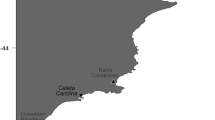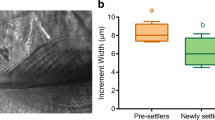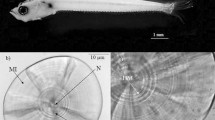Abstract
Fluctuating asymmetry (FA), defined as random deviations from perfect symmetry, has become a popular tool with which to examine the effects of stress during the development of bilaterally symmetrical organisms. Recent studies have suggested that FA in otoliths may serve as an indicator of stress in fish larvae. We examined the relationship between otolith asymmetry and temporal patterns in the occurrence of late-stage larvae to a tropical reef (i.e. replenishment) for the Caribbean lizardfish, Saurida suspicio (family Synodontidae). Late-stage larvae were collected in light traps over a period of 18 consecutive lunar months in the San Blas Archipelago, Panama. Asymmetry within otolith pairs was calculated from 24 variables: area, perimeter, longest and shortest axis of the otolith and 20 shape descriptors (Fourier harmonics). Otolith asymmetry was correlated strongly with fluctuations in lunar light trap catches. Two measured variables, otolith area and one of the 20 shape descriptors, accounted for 60% of the variability in lunar replenishment of S. suspicio. Individuals from small replenishment pulses exhibited higher levels of asymmetry compared to larvae from large pulses. When dry and wet seasons were analysed separately, otolith asymmetry explained a surprising 70 and 97% of the variation, respectively. Although the generality of these results remain to be tested among other populations and species, otolith asymmetry may be an important indicator, and potentially a predictor, of larval quality and replenishment success.



Similar content being viewed by others
References
Alados CL, Escos J, Emlen JM (1993) Developmental instability as an indicator of environmental-stress in the Pacific hake (Merluccius productus). Fish Bull 91:587–593
Anciaes M, Marini MA (2000) The effects of fragmentation on fluctuating asymmetry in passerine birds of Brazilian tropical forests. J Appl Ecol 37:1013–1028
Badyaev AV, Foresman KR, Fernandes MV (2000) Stress and developmental stability: vegetation removal causes increased fluctuating asymmetry in shrews. Ecology 81:336–345
Begg GA, Brown RW (2000) Stock identification of haddock Melanogrammus aeglefinus on Georges bank based on otolith shape analysis. Trans Am Fish Soc 129:935–945
Bergenius MA, Meekan MG, Robertson DR, McCormick MI (2002) Larval growth predicts the recruitment success of a coral reef fish. Oecologia 131:521–525
Bird JL, Eppler DT, Checkley DM (1986) Comparisons of herring otoliths using Fourier-series shape-analysis. Can J Fish Aquat Sci 43:1228–1234
Bjorksten TA, Fowler K, Pomiankowski A (2000) What does sexual trait FA tell us about stress? Trends Ecol Evol 15:163–166
Breuker CJ, Brakefield PM, Gibbs M (2007) The association between wing morphology and dispersal is sex-specific in the glanville fritillary butterfly Melitaea cinxia (Lepidoptera: Nymphalidae). Eur J Entomol 104:445–452
Campana SE, Casselman JM (1993) Stock discrimination using otolith shape-analysis. Can J Fish Aquat Sci 50:1062–1083
Campero M, De Block M, Ollevier F, Stoks R (2008) Metamorphosis offsets the link between larval stress, adult asymmetry and individual quality. Funct Ecol. doi:10.1111/j.1365-2435.2007.01381.x
Christopher RA, Waters JA (1974) Fourier series as a quantitative descriptor of miospore shape. J Paleontol 48:697–709
Clarke GM (1995) Relationships between developmental stability and fitness—application for conservation biology. Conserv Biol 9:18–24
Cushing DH (1990) Plankton production and year-class strength in fish populations: an update of the match/mismatch hypothesis. Adv Mar Biol 26:249–293
Davies CA (2002) Statistical methods for the analysis of repeated measurements. Springer, Berlin
Dufour KW, Weatherhead PJ (1998) Bilateral symmetry as an indicator of male quality in red-winged blackbirds: associations with measures of health, viability, and parental effort. Behav Ecol 9:220–231
Eriksen MS, Bakken M, Espmark A, Braastad BO, Salte R (2006) Prespawning stress in farmed Atlantic salmon Salmo salar: maternal cortisol exposure and hyperthermia during embryonic development affect offspring survival, growth and incidence of malformations. J Fish Biol 69:114–129
Eriksen MS, Espmark AM, Poppe T, Braastad BO, Salte R, Bakken M (2008) Fluctuating asymmetry in farmed Atlantic salmon (Salmo salar) juveniles: also a maternal matter? Environ Biol Fish 81:87–99
Escos J, Alados CL, Emlen JM, Alderstein S (1995) Developmental instability in the Pacific hake parasitized by Myxosporeans Kudoa Spp. Trans Am Fish Soc 124:943–945
Fey DP, Hare JA (2008) Fluctuating asymmetry in the otoliths of larval Atlantic menhaden Brevoortia tyrannus (Latrobe): a condition indicator? J Fish Biol 72:121–130
Fichtel C, Kraus C, Ganswindt A, Heistermann M (2007) Influence of reproductive season and rank on fecal glucocorticoid levels in free-ranging male Verreaux’s sifakas (Propithecus verreauxi). Horm Behav 51:640–648
Fisher R, Bellwood DR, Job SD (2000) Development of swimming abilities in reef fish larvae. Mar Ecol Prog Ser 202:163–173
Gagliano M, McCormick MI (2004) Feeding history influences otolith shape in tropical fish. Mar Ecol Prog Ser 278:291–296
Gagliano M, Depczynski M, Simpson SD, Moore JAY (2008) Dispersal without errors: symmetrical ears tune into the right frequency for survival. Proc R Soc Lond B 275:527–534
Grønkjær P, Sand MK (2003) Fluctuating asymmetry and nutritional condition of Baltic cod (Gadus morhua) larvae. Mar Biol 143:191–197
Higgs DM (2005) Auditory cues as ecological signals for marine fishes. Mar Ecol Prog Ser 287:278–281
Hilbig R, Anken RH, Sonntag G, Hohne S, Henneberg J, Kretschmer N, Rahmann H (2002) Effects of altered gravity on the swimming behaviour of fish. Adv Space Res 30:835–841
Jarvis RS, Klodowski HF, Sheldon SP (1978) New method of quantifying scale shape and an application to stock identification in walleye (Stizostedion vitreum vitreum). Trans Am Fish Soc 107:528–534
Leary RF, Allendorf FW (1989) Fluctuating asymmetry as an indicator of stress: implications for conservation biology. Trends Ecol Evol 4:214–217
Leary CJ, Garcia AM, Knapp R, Hawkins DL (2008) Relationships among steroid hormone levels, vocal effort and body condition in an explosive-breeding toad. Anim Behav 76:175–185
Leis JM, McCormick MI (2002) Recent developments in the biology, behaviour and ecology of the pelagic, larval stage of coral-reef fishes. In: Sale PF (ed) Coral reef fishes. Dynamics and diversity in a complex ecosystem. Academic, San Diego, pp 171–199
Lens L, Van Dongen S, Kark S, Matthysen E (2002) Fluctuating asymmetry as an indicator of fitness: can we bridge the gap between studies? Biol Rev 77:27–38
Leung B, Forbes MR, Houle D (2000) Fluctuating asymmetry as a bioindicator of stress: comparing efficacy of analyses involving multiple traits. Am Nat 155:101–115
Levin LA (2006) Recent progress in understanding larval dispersal: new directions and digressions. Int Comp Biol 46:282–297
Lychakov DV, Rebane YT, Lombarte A, Fuiman LA, Takabayashi A (2006) Fish otolith asymmetry: morphometry and modeling. Hear Res 219:1–11
Matessi G (1997) Is variation in orientation related to fluctuating asymmetry in migratory passerines? Ethol Ecol Evol 9:209–221
McCormick MI (1998) Behaviorally induced maternal stress in a tropical fish influences progeny quality by a hormonal mechanism. Ecology 79:1873–1883
McCormick MI (1999) Experimental test of the effect of maternal hormones on larval quality of a coral reef fish. Oecologia 118:412–422
Meka JM, McCormick SD (2005) Physiological response of wild rainbow trout to angling: impact of angling duration, fish size, body condition, and temperature. Fish Res 72:311–322
Milicich MJ, Meekan MG, Doherty PJ (1992) Larval supply: a good predictor of recruitment of 3 species of reef fish (Pomacentridae). Mar Ecol Prog Ser 86:153–166
Molony BW, Choat JH (1990) Otolith increment widths and somatic growth-rate: the presence of a time-Lag. J Fish Biol 37:541–551
Møller AP, Swaddle JP (1997) Asymmetry, developmental stability, and evolution. Oxford University Press, Oxford
Ostner J, Kappeler P, Heistermann M (2008) Androgen and glucocorticoid levels reflect seasonally occurring social challenges in male redfronted lemurs (Eulemur fulvus rufus). Behav Ecol Sociobiol 62:627–638
Øxnevad SA, Heibo E, Vøllestad LA (2002) Is there a relationship between fluctuating asymmetry and reproductive investment in perch (Perca fluviatilis)? Can J Zool 80:120–125
Palmer AR (1994) Fluctuating asymmetry analyses: a primer. In: Markow TA (ed) Developmental instability: its origins and evolutionary implications. Kluwer, Dordrecht, pp 335–364
Palmer AR (1996) Waltzing with asymmetry. Bioscience 46:518–532
Palmer AR, Strobeck C (2003) Fluctuating asymmetry analyses revisited. In: Polak M (ed) Developmental instability: causes and consequences. Oxford University Press, New York, pp 279–319
Panfili J, Durand JD, Diop K, Gourene B, Simier M (2005) Fluctuating asymmetry in fish otoliths and heterozygosity in stressful estuarine environments (West Africa). Mar Freshwater Res 56:505–516
Pankhurst NW, Hilder PI, Pankhurst PM (1999) Reproductive condition and behavior in relation to plasma levels of gonadal steroids in the spiny damselfish Acanthochromis polyacanthus. Gen Comp Endocrinol 115:53–69
Parris MJ, Cornelius TO (2004) Fungal pathogen causes competitive and developmental stress in larval amphibian communities. Ecology 85:3385–3395
Parsons PA (1990) Fluctuating asymmetry and stress intensity. Trends Ecol Evol 5:97–98
Philippi TE (1993) Multiple regression: herbivory. In: Scheiner SM, Gurevitch J (eds) Design and analysis of ecological experiments. Chapman & Hall, New York, pp 183–210
Popper AN, Ramcharitar J, Campana SE (2005) Why otoliths? Insights from inner ear physiology and fisheries biology. Mar Freshwater Res 56:497–504
Post E (2005) Large-scale spatial gradients in herbivore population dynamics. Ecology 86:2320–2328
Qualls CP, Andrews RM (1999) Cold climates and the evolution of viviparity in reptiles: cold incubation temperatures produce poor-quality offspring in the lizard, Sceloporus virgatus. Biol J Linn Soc 67:353–376
Robertson DR (1992) Patterns of lunar settlement and early recruitment in Caribbean reef fishes at Panama. Mar Biol 114:527–537
Robertson DR, Schober UM, Brawn JD (1993) Comparative variation in spawning output and juvenile recruitment of some Caribbean reef fishes. Mar Ecol Prog Ser 94:105–113
Rorabacher DB (1991) Statistical treatment for rejection of deviant values–critical-values of Dixon Q parameter and related subrange ratios at the 95-percent confidence level. Anal Chem 63:139–146
Simpson SD, Meekan M, Montgomery J, McCauley R, Jeffs A (2005) Homeward sound. Science 308:221
Sokal RR, Rohlf FJ (1995) Biometry: the principals and practice of statistics in biological research, 3rd edn. Freeman, New York
Somarakis S, Kostikas I, Peristeraki N, Tsimenides N (1997) Fluctuating asymmetry in the otoliths of larval anchovy Engraulis encrasicolus and the use of developmental instability as an indicator of condition in larval fish. Mar Ecol Prog Ser 151:191–203
Sponaugle S, Cowen RK (1996) Larval supply and patterns of recruitment for two Caribbean reef fishes, Stegastes partitus and Acanthurus bahianus. Mar Freshwater Res 47:433–447
Srinivasan M, Jones GP (2006) Extended breeding and recruitment periods of fishes on a low latitude coral reef. Coral Reefs 25:673–682
Thorrold SR, Zacherl DC, Levin LA (2007) Population connectivity and larval dispersal using geochemical signatures in calcified structures. Oceanography 20:80–89
Valles H, Sponaugle S, Oxenford HA (2001) Larval supply to a marine reserve and adjacent fished area in the Soufriere Marine Management Area, St Lucia, West Indies. J Fish Biol 59:152–177
Wellington GM, Victor BC (1989) Planktonic larval duration of 100 species of Pacific and Atlantic damselfishes (Pomacentridae). Mar Biol 101:557–567
Wilson DT (2001) Patterns of replenishment of coral-reef fishes in the nearshore waters of the San Blas Archipelago, Caribbean Panama. Mar Biol 139:735–753
Wilson DT, McCormick MI (1997) Spatial and temporal validation of settlement-marks in the otoliths of tropical reef fishes. Mar Ecol Prog Ser 153:259–271
Wilson DT, Meekan MG (2002) Growth-related advantages for survival to the point of replenishment in the coral reef fish Stegastes partitus (Pomacentridae). Mar Ecol Prog Ser 231:247–260
Witter MS, Swaddle JP (1994) Fluctuating asymmetries, competition and dominance. Proc R Soc Lond B 256:299–303
Zar JH (1999) Biostatistical analysis, 4th edn. Prentice Hall, Upper Saddle River
Acknowledgements
We are indebted to D. Wilson for collecting samples and to J. Ditty for helping with identification of lizardfish larvae. J. Shima, T. Hatley, A. Sampey and three anonymous reviewers provided useful comments on previous versions of the manuscript. We are grateful to the Kuna General Congress for permitting fieldwork in the San Blas Archipelago and to the Smithsonian Tropical Research Institute for field support. This study complied with the laws and regulations of Panama and Australia. Financial support was provided from James Cook University, Australian Institute of Marine Science, Smithsonian Tropical Research Institute and the National Geographic Society of America (NGS#5395-94).
Author information
Authors and Affiliations
Corresponding author
Additional information
Communicated by Jeff Shima.
Rights and permissions
About this article
Cite this article
Lemberget, T., McCormick, M.I. Replenishment success linked to fluctuating asymmetry in larval fish. Oecologia 159, 83–93 (2009). https://doi.org/10.1007/s00442-008-1212-x
Received:
Accepted:
Published:
Issue Date:
DOI: https://doi.org/10.1007/s00442-008-1212-x




